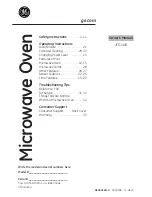
/GB-16
ENGLISH
WHAT ARE MICROWAVES?
turntable and the turntable stand or can trigger the
safety-device which will switch off the oven.
METAL
Generally speaking, metal should not be used, since
microwaves do not pass through metal and therefore
cannot reach the food. There are, however, exceptions:
small strips of aluminium foil may be used to cover
certain parts of the food, so that these do not thaw too
quickly or begin to cook (e.g. chicken wings). Small
metal skewers and aluminium containers (e.g. of ready-
cooked meals) can be used. They must, however,
be small in relation to the food, e.g. aluminium
containers must be at least
2
/
3
to
3
/
4
filled with food.
It is recommended that you transfer the food into a
dish suitable for use in the microwave. When using
aluminium containers or other metal utensils there must
be a gap of approx. 2 cms between them and the
walls of the cooking area, otherwise the walls could
be damaged by possible arcing.
NO UTENSIL SHOULD HAVE A METAL
OVERLAY -
parts such as screws, bands or handles.
UTENSIL SUITABILITY TEST
If you are not sure whether your utensil
is suitable for use in your microwave
oven, carry out the following test: Place
the utensil into the oven. Place a glass
container filled with 150 ml of water on
or next to the utensil. Switch on the oven at 800 W
power for 1 to 2 minutes. If the utensil stays cool or
just warm to the touch, it is suitable. Do not use this test
on a plastic utensil. It could melt.
Microwaves are generated in the microwave oven by a
magnetron and cause the water molecules in the food
to oscillate.
Heat is generated by the friction which is caused, with
the result that the food is thawed, heated or cooked.
GLASS AND CERAMIC GLASS
Heat-resistant glass utensils are very
suitable. The cooking process can be
observed from all sides. They must not,
however, contain any metal (e.g. lead
crystal), nor have a metallic overlay
(e.g. gold edge, cobalt blue finish).
CERAMICS
Generally very suitable. Ceramics must be glazed,
since with unglazed ceramics moisture can get into
the ceramic. Moisture causes the material to heat up
and may make it shatter. If you are not certain whether
your utensil is suitable for the microwave, carry out the
utensil suitability test.
PORCELAIN
Very suitable. Ensure that the porcelain does not have
a gold or silver overlay and that it does not contain
any metal.
PLASTIC AND PAPER UTENSILS
Heat resistant plastic utensils which are suitable for use
in the microwave can be used to thaw, heat and cook
food. Follow the manufacturer’s recommendations.
Heat-resistant paper made for use in a microwave
oven is also suitable. Follow the manufacturer’s
recommendations.
MICROWAVE FOIL
This, or heat-resistant foil, is very suitable for covering
or wrapping. Please follow the manufacturer’s
recommendations.
ROASTING BAGS
Can be used in a microwave oven. Metal clips are
not suitable for fastening them since the roasting bag
foil might melt. Fasten the roasting bag with string
and pierce it several times with a fork. Non heat-
resistant food wraps are not recommended for use in a
microwave oven.
BROWNING DISH
A special microwave dish made from ceramic glass
with a metal alloy base, which allows food to be
browned.
When using the browning dish a suitable insulator, e.g. a
porcelain plate, must be placed between the turntable
and the browning dish. Be careful to adhere exactly
to the pre-heating time given in the manufacturer’s
instructions. Excessive pre-heating can damage the
SUITABLE OVENWARE
160
















































